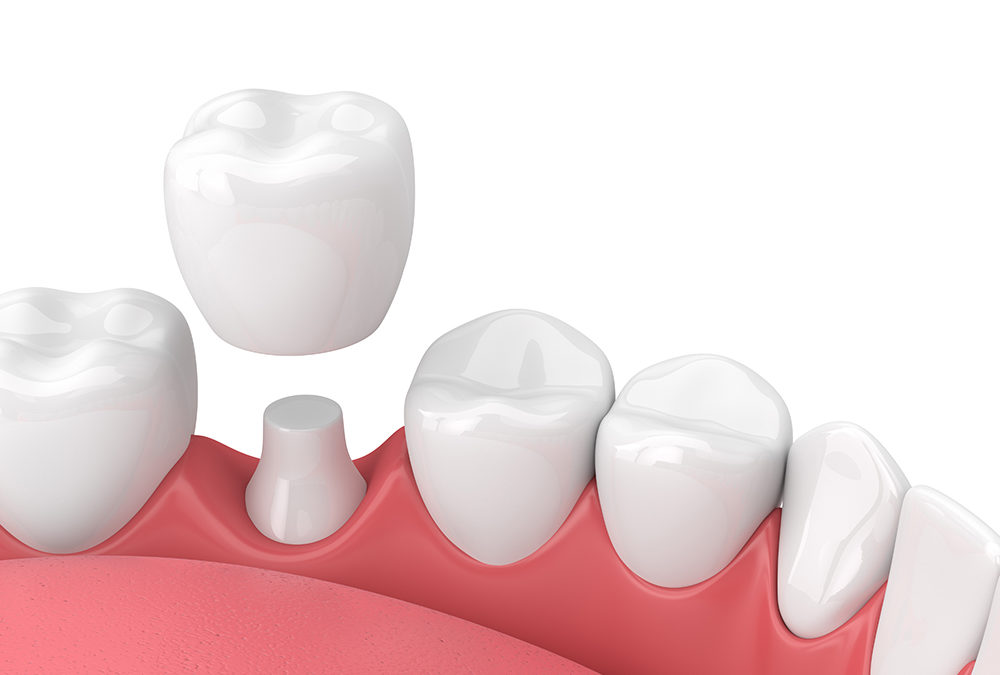What is Tooth Crown?
A tooth crown is a cap made of an artificial material that is used to restore the strength, function, and appearance of a tooth. They are typically used on damaged, broken, or root canal-treated teeth, and when one tooth or a few teeth are missing, dental bridges are used to replace them. Crowns can also be used on top of dental implants for the same purpose.
- Tooth crowns have been around for a long time. Previously, they were made of gold alloys, nickel alloys, or cobalt-chromium alloys. Later, tooth-colored dental ceramics were added on top of these alloys to make the dental crown look like a tooth. However, the presence of metal beneath the ceramic made it difficult to give these crowns a lifelike appearance. The metal’s opacity was always visible, and it was difficult to match the translucency of natural teeth.
- To address this issue, dental crowns were entirely made of ceramic. These were aesthetically pleasing, but it lacked strength. These crowns were always prone to fracture, and discoloration of the underlying natural teeth showed through. They were also ineffective for bridges that replaced a large number of teeth. Then came the revolutionary dental material, zirconia.
What is a zirconium tooth crown?
Zirconia is a metal oxide derived from zirconium. Zirconia is an excellent material for tooth crowns due to its natural strength and durability. Zirconia tooth crowns are ideal for patients who require posterior crowns with high chewing strength.
What is PFM’s crown?
Porcelain-fused-to-metal (PFM) crowns, as the name implies, combine porcelain and metal. The porcelain overlay matches the natural teeth in colour, but the darker metal color may show at the gum margin, particularly if there is a gingival recession. PFM restorations are typically recommended by dentists for patients who want strength and a natural appearance.
Why Is Zirconia Better Than PFM?
- Excellent Strength
- Natural looking Smile
- Durability
- Individualization
- Safe
- Maintenance
- Comfort
- Excellent Strength:
For tooth crowns, zirconia provides superior strength and durability. It is three times as strong as porcelain or PFM restorations. Zirconia, unlike porcelain, can withstand wear and tear without chipping, so zirconia restorations can withstand the forces of mastication and bruxism (teeth grinding). This crown is nearly unbreakable and built to withstand the harsh oral environment, especially in the posterior area of the mouth.
- Natural-looking Smile:
At the gingival margin, zirconia has no metal lining. Porcelain-fused-to-metal (PFM) crowns have a metal layer beneath the porcelain layer. When patients smile, this metal lining is usually visible in the gums. Zirconia crowns eliminate the need for a metal lining entirely, allowing patients to smile with confidence. Furthermore, zirconia crowns can be shaped and sized to match the rest of a patient’s teeth.
- Durability:
Zirconia is even more durable than PFM ceramics. Zirconia, contains more stabilizers than PFM ceramics, making it more resistant to forceful mastication and grinding. Zirconia restorations, if properly cared for, can last a patient’s entire life.
- Individualization:
There are numerous ways zirconia can be manufactured to meet the needs of the patient due to various factors such as chemical composition and processing requirements. This personalization reduces the margin for error and ensures a perfect fit for each individual.
- Safe:
Patients who are allergic to the alloys used in PFM restorations will not develop allergies due to zirconia’s high biocompatibility. Zirconia has excellent biocompatibility, making zirconia crowns and bridges extremely safe for clinical use.
- Maintenance:
Metal ceramic crowns, like natural teeth, require regular brushing and flossing. Because of its smooth surface, a zirconia crown is very effective in reducing the presence of plaque and tartar accumulations.
- Comfort:
Both are simple to use and comfortable. Temperature fluctuations are not transmitted to natural teeth by zirconia. As a result, there is no risk of hypersensitivity because they are resistant to heat and cold.
Zirconia restorations have been used successfully for many years and provide excellent strength, durability, and true-to-life aesthetics to patients. At the moment, the demand for zirconia far outweighs the demand for PFMs, and these older-style restorations are becoming outdated.
The crown choice for each individual may differ depending on their health conditions and anatomical considerations. Our dentists evaluate your needs and concerns to recommend the best treatment option for you.


